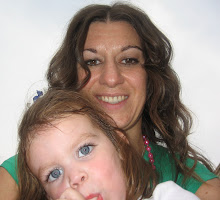Hadley has been in Sunday School for two years now at our church, and since she's started, we've been talking more about God. Where is God? Who is God? What is Heaven? How do we get there? Does God have a mustache?
I enjoy these conversations Hadley and I have about God, but I worry I don't answer her questions in a satisfying way. Where is God? Would she understand if I said I see Him in her little fingers and blue eyes? Or would that freak her out? Where is Heaven? If I told her I am not exactly sure where Heaven is but I thought maybe I was at its doorstep the first time I held her in my arms, can she appreciate that? Or would she prefer a description of a place where you play at a park all day and eat M and Ms and drink chocolate milk?
The best way I know to discuss issues such as faith with Hadley is through stories. Hadley likes a good story, and I have learned that our conversations become much richer when we delve into the pictures, characters, and plot. One book that has given Hadley and I an opportunity to think and talk about God is Miriam in the Desert by Jacqueline Jules. This is the story of Miriam and Bezalel as they walk through the desert after leaving Egypt. We've been reading it for the better part of a week now.
The first thing Hadley notices about stories is the pictures. While we were reading Miriam in the Desert, she would comment frequently on the people in each picture. I think the illustrator, Natascia Ugliano, did a great job of creating emotion in the people's faces, and one thing that I loved the most about this book, and that Hadley picked up on, was that people's faces were different when they were experiencing a gift from God, or hearing His voice.
For example, when the group wakes to find something that looks like "shining pearls" on the ground, and they eat it, Hadley notices that some people look worried, and some look happy. She didn't understand why everyone wasn't feeling the same way. Through reading the story out loud, Hadley and I learned that the people had different reactions to what they were eating. Some thought it tasted like honey, some like bread. "The flavor is special in each person's mouth," Miriam tells Bezalel.
"So not everyone liked it?" Hadley asked me.
"Well, I think they all liked it, it's just that they all had different reactions to having food suddenly when before there was none," I tell her.
My favorite part in this story is the part where God speaks to everyone from the mountain. I wonder if Hadley could tell this is an important part in the story by the change in the pictures. Instead of the color orange that dominates the background, for three or four pages, the colors are blues and purples. The people are much smaller, too, giving a sense of awe at what is about to happen.
When God speaks to the group, everyone had a different reaction as well. Hadley and I stop for awhile at this page with several people looking at one another, discussing what just happened. Hadley comments that they look afraid. When I read the words on the page, we learn that some thought the voice was a strong voice. Others heard the voice in a whisper. Miriam tells the group that "God speaks to each one of us in the way we understand best."
I love this sentence, and for me, it is an important concept that I want to teach both Hadley and Harper. Sometimes the girls and I will read Miriam in the Desert and we'll talk about Moses. Sometimes we'll read it and we'll talk about the cloud that leads them during the day, or the fire that leads them at night. Through this story I can help the girls learn about the Ten Commandments, and Bezalel, who Miriam told him, "God has made you an artist." And each time we read the story, we have a chance to listen to God speaking to us, in a "way we understand best." I'm thankful Miriam in the Desert helped Hadley and I begin to do just that.
Brooding Upon the Waters
2 days ago

Thank you, Callie, for such a thoughtful examination of my book. And it is so powerful for me to hear the reaction of children. Thank you for sharing Miriam in the Desert with your daughter and for talking about it at Sit a While.
ReplyDeleteBest,
Jacqueline Jules
www.jacquelinejules.com
I'm very glad you have girls who are older than Joshua, so I can borrow from your observations and books you have read.
ReplyDeleteAnd I agree that some of those questions Hadley asks are going to be difficult to answer once they come from my son. I do think it's going to be a wonderful way for me to learn to express my faith, though, and try to see it through the eyes of someone else.
So......did you tell her God had a mustache? Just curious.